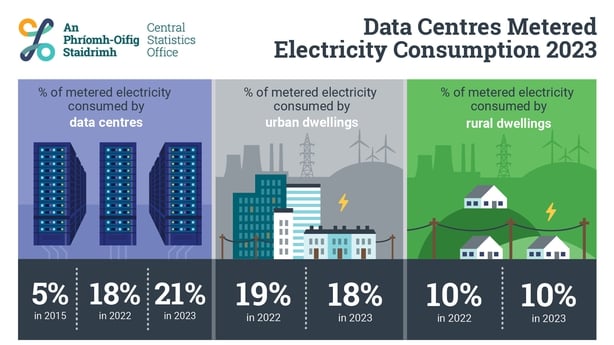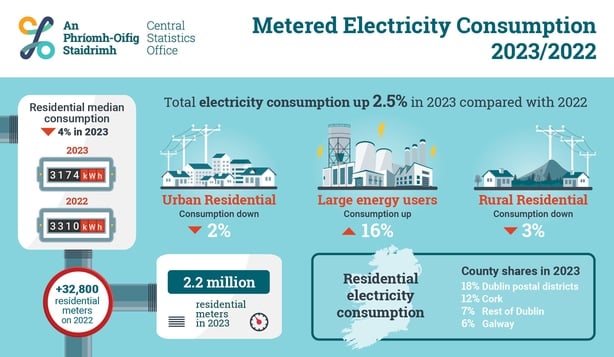More renewable energy will be vital to keep pace with demand from data centres, particularly if more are to be built here, an environmental scientist has warned.
It comes as new figures from the Central Statistics Office (CSO) showed that electricity consumption by data centres increased by 20% between 2022 and last year.
CEO of Change by Degrees Dr Tara Shine described the findings as concerning because increased electricity consumption results in more carbon emissions.
The CSO figures show that the percentage of total metered electricity consumption used by data centres rose from 5% in 2015 to 21% in 2023.
Quarterly metered electricity consumption by data centres increased steadily from 290 Gigawatt hours in the first quarter of 2015 to 1,661 Gigawatt hours in the fourth quarter of 2023 - a jump of 473%.
Dr Shine said this is happening at a time when Ireland is trying to reduce its carbon emissions and trying to "stick to our targets".
She said awareness and "efficiency" among consumers is also important.
"The more that we use generative AI, the more we store in the cloud, the more messy housekeeping we all do of our cloud storage, the more data that takes," Dr Shine said.
"Being efficient with our use of the cloud can be another thing we can think of," she added.

The CSO also said that urban households accounted for 18% and rural households for 10% of total metered electricity consumption last year.
Separate figures from the CSO today show that Large Energy Users - which include big data centres and the highest electricity consumers in other sectors such as IT and cement manufacturing - used 30% of metered electricity consumption in 2023.
This exceeded the combined total of Urban Residential (18%) and Rural Residential (10%) use.
The CSO said that consumption by large energy users increased by 16% between 2022 and 2023 and soared by 151% between 2015 and 2023.
It noted that the peak demand period for very large energy users occurred between 1pm and 3pm.
We need your consent to load this rte-player contentWe use rte-player to manage extra content that can set cookies on your device and collect data about your activity. Please review their details and accept them to load the content.Manage Preferences
The CSO said that total metered electricity consumption was 30,600 GWh (gigawatt hours) in 2023, an increase of 2.5% compared with the previous year.
Residential metered electricity consumption came to 8,579 GWh last year, a 2% decrease compared with 2022, with urban residential consumption down 2% and rural residential consumption 3% lower.
Meanwhile, metered electricity consumption by electric vehicles charge points rose by 38% from 17 GWh in 2022 to 23 GWh last year.

The CSO figures show show an 8% increase in the number of residential meters between 2015 and 2023.
The highest increases were in counties adjacent to Dublin City, with residential meters in Kildare and Meath both up by 17%.
Meanwhile, Dublin Postal Districts had the highest proportion of residential consumption in 2023 at 18%, followed by Cork (12%), Dublin County (7%), Galway (6%) and Kildare (5%).
The CSO noted that median residential electricity consumption was down in every county last year compared with 2022.
Donegal, Leitrim and Mayo had the lowest median residential consumption in 2023, while Kildare had the highest figure.
Minister for the Environment, Climate and Communications Eamon Ryan said data centres are part of the economy.
"We do want data centres but they have to live within the climate limits that we have and also the power and grid limits and that's something that the CRU (Commission for Regulation of Utilities) is coming out with their connection policy.. That's what we can and will manage and do"







